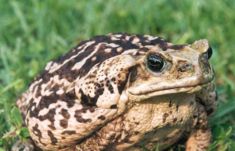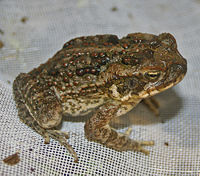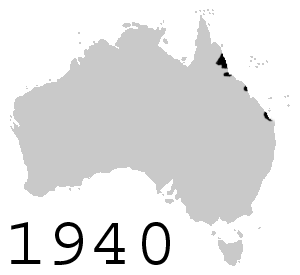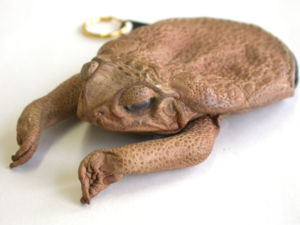Cane Toad
2008/9 Schools Wikipedia Selection. Related subjects: Insects, Reptiles and Fish
| Cane Toad | ||||||||||||||
|---|---|---|---|---|---|---|---|---|---|---|---|---|---|---|
 |
||||||||||||||
| Conservation status | ||||||||||||||
| Scientific classification | ||||||||||||||
|
||||||||||||||
| Binomial name | ||||||||||||||
| Bufo marinus (Linnaeus, 1758) |
||||||||||||||
 Distribution of the Cane Toad. Native distribution in blue, introduced in red.
|
||||||||||||||
| Synonyms | ||||||||||||||
|
Chaunus marinus |
The Cane Toad (Bufo marinus), also known as the Giant Neotropical Toad or Marine Toad, is a large, terrestrial true toad native to Central and South America. It is a member of the subgenus Chaunus of the genus Bufo, which includes many different true toad species throughout Central and South America. The Cane Toad is a prolific breeder; females lay single-clump spawns with large numbers of eggs. Its reproductive success is partly because of opportunistic feeding: it has a diet, unusual among Anurans, of both dead and living matter. Adults average 10 to 15 centimetres (4–6 in) in length; the largest recorded specimen weighed 2.65 kg (5.8 lb) with a length of 38 cm (15 in) from snout to vent.
The Cane Toad has poison glands, and the tadpoles are highly toxic to most animals if ingested. Because of its voracious appetite, the Cane Toad has been introduced to many regions of the Pacific and the Caribbean islands as a method of agricultural pest control, notably failing in the case of Australia in 1935, and derives its common name from its use against the greyback cane beetle pests. The Cane Toad is now considered a pest in many of its introduced regions, because its toxic skin kills many native predators when ingested. It has many negative effects on farmers because of pets and animals eating the creatures.
Taxonomy
The common name of "Cane Toad" is derived from the original purpose of using it to eradicate pests in sugar cane crops. The Cane Toad has many other common names, including "Giant Toad" and "Marine Toad"; the former refers to their size, and the latter to the binomial name, Bufo marinus. It was one of the many species originally described by Linnaeus in his 18th century work Systema Naturae. Linnaeus based the specific epithet, marinus, on an illustration by Albertus Seba, who mistakenly believed the Cane Toad to inhabit both terrestrial and marine environments. Other common names include "Giant Neotropical Toad," "Dominican Toad," "Giant Marine Toad," and "South American Cane Toad." In Trinidadian English they are commonly called "Crapaud" (the French name for "toad").
In Australia, the adults may be confused with species of the Limnodynastes, Neobatrachus, Mixophyes, and Notaden genera. These species can be readily distinguished from the Cane Toad by the lack of large parotoid glands behind their eyes. Cane toads have been confused with the Giant Burrowing Frog (Heleioporus australiacus), because both are large and warty in appearance; however, the Giant Burrowing Frog can be readily distinguished from the Cane Toad by its vertical pupils. Juvenile Cane Toads may be confused with species of the Uperoleia genus, because they all have large parotoid glands; juvenile Cane Toads can be distinguished from these species by the ridging around their eyes and the lack of bright colouring on their thighs.
In the United States, the Cane Toad closely resembles many Bufonid species. In particular, it could be confused with the Southern toad (Bufo terrestris) and Fowler's toad (Bufo fowleri). The Southern Toad can be distinguished by the presence of two bulbs in front of the parotoid glands, and the Fowler's Toad has a pale, cream-white stripe that runs down the dorsal surface; the Cane Toad lacks this stripe.
It is possible to confuse the Cane Toad with the Rococo Toad (Bufo schneideri), sometimes referred to as Schneider's Toad, whose range overlaps that of the Cane Toad. The Rococo Toad grows to nearly the same size but has additional poison glands on its back legs which can be used to reliably identify it. Within its native range, the Cane Toad can be distinguished from the other true toads by the shape of its paratoid glands and the arrangement of the ridges on its head.
Description
The Cane Toad is very large; the females are larger than males, reaching an average length of 10–15 centimetres (4–6 in), and much longer in some cases. "Prinsen", a toad kept as a pet in Sweden, is listed by the Guinness Book of Records as the largest recorded specimen. It reportedly weighed 2.65 kilograms (5.84 lb) and measured 38 centimetres (15 in) from snout to vent, or 54 centimetres (21 in) when fully extended. (3 lb). They have a life expectancy of 10 to 15 years in the wild and as long as 20 years in captivity.
The skin of the Cane Toad is dry and warty. It has distinct ridges above the eyes which run down the snout. Cane Toads can be grey, brown, red-brown or olive in colour, with varying patterns. A large parotoid gland lies behind each eye. The ventral surface is cream and may have blotches in shades of black or brown. The pupils are horizontal and the irises golden. The toes have a fleshy webbing at their base, and the fingers are free of webbing.
Juvenile Cane Toads are much smaller than adult cane toads—only 5 to 10 millimetres (0.2–0.4 in) long. Typically, they have smooth, dark skin, although some specimens have a red wash. Juveniles lack the adults' large parotoid glands, so they are usually less poisonous. Because they lack this key defence, it is estimated that only 0.5% of metamorph Cane Toads reach adulthood. The tadpoles are small and uniformly black. They are bottom-dwellers and congregate around plants forming schools. Tadpoles reach 27 millimetres (1 in) in length but are smaller—up to 22 millimetres (0.9 in)—under overcrowded conditions.
Ecology, behaviour and life history
Adult Cane Toads possess enlarged parotoid glands behind the eyes and other glands across the back. When threatened, the Cane Toad secretes a milky-white fluid known as bufotoxin from these glands. Bufotoxin contains components that are toxic to many animals. There are many reported deaths of animals and even reported deaths of humans, after consumption of Cane Toads. A Cane Toad is capable of inflating its lungs, puffing up and lifting its body off the ground to appear taller and larger to a predator.
Most frogs identify prey by their movements; Cane Toads can also locate food using their sense of smell. They are therefore not limited to living prey and can eat plants, carrion, dog food and household refuse apart from the normal frog prey of small vertebrates and a range of invertebrates. They are active primarily at night and can range far from water.
The common name of "Marine Toad", and the scientific name Bufo marinus, suggest a link to marine life; however, there is no such link. Adult Cane Toads are entirely terrestrial, venturing to fresh water to breed, and tadpoles have been found to only tolerate salt concentrations equivalent to 15% that of sea water. Both eggs and tadpoles are toxic to many animals. This toxic protection remains at all life stages and very young cane toads kill small reptiles that eat them. Cane Toads inhabit open grassland and woodland, generally avoiding heavily forested areas; this inhibits their spread in many of the regions in which they were introduced.
Many species prey on the Cane Toad in its native distribution. These include the Broad-snouted Caiman (Caiman latirostris), the Banded Cat-eyed Snake (Leptodeira annulata), the eel (family: Anguillidae), various species of killifish, the Jungle Perch (Kuhila rubestris), some species of catfish (order: Siluriformes) and some species of ibis (subfamily: Threskiornithinae). Predators outside the Cane Toad's native range include the Whistling Kite (Haliastur sphenurus), the Rakali (Hydromys chrysogaster), the Black Rat (Rattus rattus) and the Water Monitor (Varanus salvator). Occasional cases of the Tawny Frogmouth (Podargus strigoides) and the Papuan Frogmouth (Podargus papuensis) and afuran snakes (Acrochordus arafurae) feeding on Cane Toads have been reported. These predators possess either a tolerance to the Cane Toad's toxins or behavioural adaptations that allow them to avoid the most poisonous areas of the frog as they hunt and consume it.
Poison
Bufotenin, one of the chemicals excreted by the Cane Toad, is classified as a Class 1 drug under Australian drug laws. This is the same classification as heroin and marijuana. It is thought that the effects of bufotenin are similar to that of mild poisoning; the stimulating effect, which includes mild hallucinations, lasts for less than one hour. Since the Cane Toad excretes bufotenin in very small amounts, and other toxins in relatively large amounts, toad licking could result in serious illness or death.
Distribution
The Cane Toad is native to the Americas, from the Rio Grande Valley in southern Texas to central Amazon and south-eastern Peru. This range includes both tropical and semi- arid environments. The density of the Cane Toad within its native distribution is significantly lower than that of its introduced distribution. In South America, it is recorded at densities of 20 adults per 100 metres of shoreline, but in Australia the density reaches 1,000–2,000 adults over the same area.The Cane Toad was originally brought to Australia to eat the Cane grub.
Introductions
The Cane Toad has been introduced to many regions of the world, particularly the Pacific, for the biological control of agricultural pests. Up until 184, Cane Toads had been introduced into Martinique, Barbados and Jamaica. They were unsuccessfully introduced into Jamaica to control the rat population.
In 1920, Cane Toads were introduced into Puerto Rico to control the populations of white-grub (Phyllophaga spp.), a pest of sugar cane. By 1932, the Cane Toad was well established on the island, and the populations of white-grubs were dramatically decreased. The decrease in the white-grub population was attributed to the Cane Toad, although there may have been other factors. The six year period after 1931 (when the Cane Toad was most prolific, and the white-grub saw dramatic decline) recorded the highest ever rainfall for Puerto Rico. However, the assumption that the Cane Toad controlled the white-grub led to the large scale introductions throughout many parts of the Pacific.
There are introduced populations in Australia, Florida, Papua New Guinea, the Philippines, the Ogasawara and Ryukyu Islands of Japan, most Caribbean islands and many Pacific islands, including Hawaii and Fiji. Cane Toads were introduced into Fiji to combat insects which infest sugar cane plantations. The introductions generally failed to control the targeted pests, most of which were later controlled by the use of insecticides. Since then, the Cane Toad has become a pest in the host countries, posing a serious threat to native animals. The introduction of the Cane Toad has had a particularly great effect on Australian biodiversity. This is probably because of the large number of species that the Cane Toad successfully competes with and the large areas of open grassland and open woodland.
The Cane Toad was successfully introduced into New Guinea to control the hawk moth larvae, which were eating the sweet potato crops. Cane Toads have since become abundant in rural and urban regions and have not penetrated the forested areas; because most of the native wildlife is restricted to forested areas, the Cane Toad has not caused significant environmental problems.
Australia
The cane toad in Australia is regarded as an exemplary case of a " feral species" -- others being rabbits, foxes, cats, and Giant Mimosa. The island-continent's relative isolation prior to European colonisation and the industrial revolution -- both of which dramatically increased traffic and importation of novel species -- allowed development of a complex, interdepending system of ecology, but one which provided no natural predators for many of the species subsequently introduced. The recent, sudden inundation of foreign species has led to severe breakdowns in Australian ecology, after overwhelming proliferation of a number of introduced species for which the continent has no efficient natural predator or parasite, and which displace native species -- in some cases these species are physically destructive to habitat as well.
Cane Toads were introduced to Australia from Hawaii in June 1935 in an attempt to control the native Cane Beetle (Dermolepida albohirtum). They bred immediately in captivity, and by August 1935 more than 3,000 young toads were released in areas around Cairns, Gordonvale and Innisfail in northern Queensland. More toads were released around Ingham, Ayr, Mackay and Bundaberg. Releases were temporarily limited because of environmental concerns but resumed in other areas after September 1936. Since their release, toads have rapidly multiplied in population and now number over 200 million and have been known to spread diseases affecting local biodiversity. The toads have steadily expanded their range through Queensland, reaching the border with New South Wales in 1978 and the Northern Territory in 1984. The toads on the western frontier of their advance have evolved larger legs; this is thought to be related to their ability to travel farther. As a consequence of their longer legs, larger bodies, and faster movement, about 10% of the leading edge Cane Toads have also developed arthritis. It is estimated that Cane Toads migrate at an average of 40 kilometres (25 mi) per year.
The long-term impact of toads on the Australian environment is difficult to determine. Precipitous declines in populations of the Northern Quoll (Dasyurus hallucatus) have been observed after toads have invaded an area. There are a number of reports of declines in goanna and snake populations after the arrival of toads. The preliminary risk assessment of Cane Toads in Kakadu National Park stated that the predation of the Cane Toad by native wildlife is the greatest risk to biodiversity. Other factors, such as competition with native wildlife for resources, and the predation of the Cane Toad on native wildlife, were considered much lower risk factors. In the Northern Territory, goanna predation on cane toads has been linked to a rise in the amount of undamaged salt water crocodile eggs. Cane toads were present within a few days of the crocodiles hatching in April, 2007.
Numerous native species have been reported as successfully preying on toads. Some birds, such as the Black Kite (Milvus migrans), have learned to attack the toad's belly, avoiding the poison producing glands on the back of the head. Reports in the Northern Territory suggest that a native frog, Dahl's Tree Frog (Litoria dahlii), is able to eat the tadpoles and live young of the toad without being affected by the poison that often kills other predators. This is believed to account for slower than expected infestations of toads in certain areas of the Northern Territory. Some snakes have been reported to have evolved smaller jaws so that they are unable to swallow large Cane Toads which have large quantities of poison. Another study, however, notes that the Cane Toad is adapting to a wider environmental range and may in the future be spreading into habitats currently not available.
As of 2005, ultraviolet light which attracts the moths the toads love has been used to lure and capture Cane Toads for extermination. In June 2006, the University of Queensland announced research into a gene to reverse the sex of female Cane Toads. This would lead to a population of males, and thus eliminate the population.
In popular culture
The introduction and migration of the Cane Toad in Australia was popularised by the film Cane Toads: An Unnatural History (1988), which tells the tale with a humorous edge and is often shown in Environmental Science courses. Don Spencer, a popular children's entertainer, sang the song " Warts 'n' All", which was used in the documentary.
The toxic skin is regarded by some as a useful drug, and has been smoked to obtain its hallucinogenic effects.
In Australia, attempts have been made to make use of dead Cane Toads, which can number in the thousands and cause hygiene problems. This includes processing the carcasses into liquid fertilisers. Their skin can be made into leather, and comical cane-toad purses, or coin-purses, retaining the toad fore-body, are sometimes seen (eg see accompanying photo). Cane toads have also been known to be a significant source of food for humans in their native environment; cane toads are cooked by skinning them and taking out the internal organs (including the poisonous glands), and then roasting them. Many people who have eaten cane toads say they are like chicken except with a drier taste.
In Australian states where the Cane Toad is common, some rather cruel 'sports' have developed, such as Cane Toad golf and Cane Toad cricket, where cane toads are used as balls. In April 2005, Dave Tollner, a Northern Territory Member of Parliament, called for legalisation of attacking Cane Toads. This was criticized by many animal and conservation groups who claim freezing is a more humane way to kill cane toads than hitting them with cricket bats. The short film " Cane Toad - What happened to Baz?" displays an Australian attitude towards the Cane Toad. This film won the "Best Comedy" award at the 2003 St Kilda Film Festival. The film relies on humour which Australians especially connect with, and screenings in overseas festivals have been less well received.
The Cane Toad has been listed by the National Trust of Queensland as a state icon of Queensland, alongside the Great Barrier Reef, and past icons, the Royal Flying Doctor Service and the backyard mango tree (also an introduced species).
Cane Toad is also a colloquial term for an inhabitant of Queensland, particularly the state's State of Origin football team members and supporters.
In an episode of The Simpsons entitled " Bart vs. Australia", Bart Simpson tries to bring a bullfrog into Australia only to find that foreign organisms are not permitted through customs. He decides to leave the frog at a fountain in the airport but the frog quickly escapes through an open window. Throughout the rest of the episode, bullfrogs are seen rapidly multiplying and becoming an overall nuisance. By the end of the episode, as the Simpsons escape the American consulate via helicopter, the entire continent is shown to be overrun with frogs.



